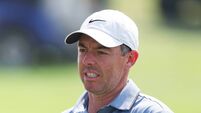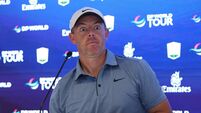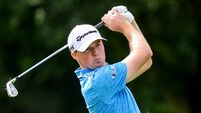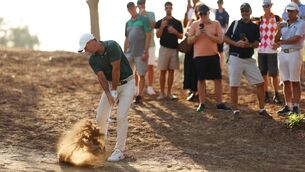Endurance test will find worthy winner
The USGA like to make things as difficult as possible believing, in their own words, that “this is the way to identify the best player”.
Does it work like that? Does it hell! Three years ago at Pinehurst, New Zealander Michael Campbell came out on top, proving too strong down the stretch for none other than Tiger Woods. The trouble, of course, is that Campbell had done virtually nothing in the preceding five or six years and had to abandon his plans to play the US Tour and return to the relative security of Europe. However, that strategy has backfired as well.
“Cambo” has done little since Pinehurst and how he successfully looked Tiger in the eye that scorching evening in North Carolina becomes a greater mystery with the passing of every tournament.
He has tried his luck in the States on three occasions this year shooting rounds of 81 and 83 in Houston; 77 and 71 at the Masters and 74 and 78 at the Players Championship and missed the cut in all three. In nine appearances in Europe, the Kiwi has missed out seven times and, when he did survive, came in 35th in the Asian Open and 70th in Qatar.
These are appalling results for a US Open champion of such recent vintage. It doesn’t necessarily mean that the event loses some of its lustre.
Nor does the sight of a mini-tour player, Hicks, and a US Tour rookie, Streelman, leading after the first round at Torrey Pines.
But there’s also the failure of Woods to capture his own national Open over a six-year spell in which he has completely dominated if not downright bullied his rivals. He can beat them almost every time he tees it up in ordinary tour events but it’s been a completely different story in the biggest week of all as far as American golfers are concerned.
Furthermore, Phil Mickelson’s name has yet to appear on the trophy, another classic example of why people accuse the USGA of identifying the “wrong” champions because they set up their courses in such an extravagantly difficult fashion. However they don’t quite see things in that light, a point strenuously made this week by vice-president Jim Hyler.
“The course set-up is consistent, has been, and will be consistent with our fourteen point US Open philosophy,” he declared. “This philosophy was developed in the fall of 2004 and guided our set-up in 2005, ‘06 and ‘07. And we’ve had three very successful Opens using these points as a basis. Simply put, our philosophy is that the Open should be the most rigorous examination of golfers at the highest level while also wanting the course to be fair. We want the championship to challenge and test all aspects of a player’s game — shot making, mental tenacity and physical endurance.”
Hyler placed special emphasis on rough height, density and severity, hole location and risk and reward options. He claimed there would be evidence of all those tenets during the championship and in that respect he has been more or less vindicated although the rough has been disappointingly and perhaps unfairly inconsistent. I have seen golf balls land within a few feet of each other in the primary rough where one player reached the green without undue difficulty and the other could do no more than chop out to the fairway.
In fairness, though, the British Open with its links course venues is an even bigger culprit in this regard and it is only right, too, to point out that the US Open has produced many memorable moments. Dan Jenkins, the doyen of the media centre, was regaling his listeners
earlier in the week about the 1955 championship when a certain Jack Fleck (who would have been as well-known at the time as, say, Justin Hicks) got himself into a play-off and went on to defeat, of all people, Ben Hogan.
Then there were the spectacular collapses by some of the game’s icons. In 1966 at Olympic, San Francisco, where Fleck had achieved the seemingly impossible 11 years earlier, Arnold Palmer was leading by seven shots with nine to play. He took 39 to come home, Billy Casper covered the same journey in 32 and won the play-off. Of more recent vintage were the double bogeys run up by Phil Mickelson and Colin Montgomerie at Winged Foot two years ago when a par would have ensured either one of the title.
NBC, with Johnny Miller as the spearhead, has provided the television coverage for many years and in spite of the many irritating commercial breaks, do a very fine job. They did have blimp glitches as they covered Mickelson’s mishaps of ‘06 but they still provided wonderful sporting theatre as it gradually developed into a horror story.
The US Open was tailor made for a golfer of the power and tactical acumen of Jack Nicklaus. He won it on four occasions but almost as impressive was his 18 top ten finishes. Nearest to that are Ernie Els, Mickelson, Jeff Maggert and Vijay Singh with seven while Woods so far has five.
And the best US Open shot of all time? Take your pick of, a), Palmer driving the first green at Cherry Hills in 1960 on the way to the greatest of all his many famous comebacks; b), Francis Ouimet’s 71st green birdie putt at Brookline in 1913 that spurred the youngster’s rally to tie the great Englishman Harry Vardon and beat him in a play-off (as recorded in Mark Frost’s outstanding book “The Greatest Game Ever Played”) and c), Tom Watson’s chip in, again on the 71st, at Pebble Beach in 1982, that denied Nicklaus a record fifth title.
For all its wrinkles and faults, the US Open remains a great championship. Let’s hope it produces a worthy champion here tomorrow evening.
















